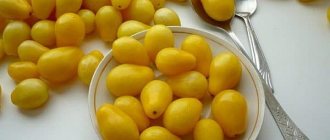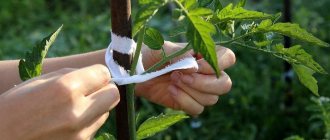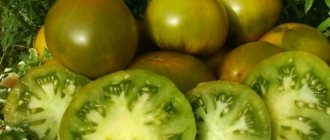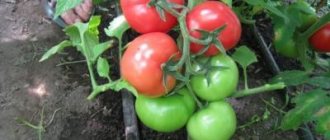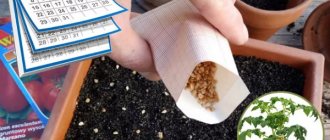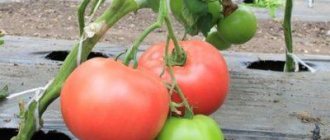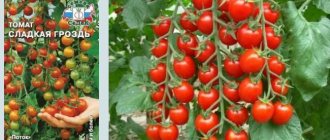Antonovka Medovaya is a new variety bred by Russian breeders. It will appeal to those who like to experiment by planting something unusual in their garden.
| Height | Landing location | Ripening time | Fruit color | Fruit size | Origin | Fruit shape |
| Medium height | Greenhouse, Open ground | Mid-season | Greens | Average | Variety | Round |
Description of the variety
In terms of ripening time, “Antonovka Medovaya” belongs to the mid-season varieties. From planting the seed for seedlings to the technical maturity of the fruit, 110-112 days pass.
Despite the fact that tomatoes are determinate plants, they require tying to supports and pinching of lateral shoots.
The Antonovka Medovaya variety is a universal crop. Tomatoes are grown in open ground, under film covers and in greenhouses.
REFERENCE: In ordinary beds, bushes grow in height from 110 to 130 cm, under film and in greenhouses - up to 150 cm.
Description of the fruits of the Antonovka Honey variety:
- Round and slightly flattened shape;
- Dense smooth skin;
- Ripe fruits have an unusual green color with yellow streaks;
- The tomato pulp is rich pink in color;
- Great taste;
- Dense and juicy pulp;
- The average weight of tomatoes is from 180 to 220 grams.
Not my favorite varieties. Tomatoes Watermelon and Antonovka honey
Watermelon
I grew a lot of interesting, tasty and beautiful tomatoes this year. But there are a couple that I didn’t like, or didn’t work out, or are just a remake...
These are Watermelon and Antonovka honey tomatoes. Both determinants, i.e. they finished their growth early, forming a flower cluster at the end. I was unable to transfer them to “stepchildren” in order to prolong growth and fruit formation - they did not produce stepchildren...
Watermelon, maybe because the pulp is so...
The watermelon one turned out to be completely different from a watermelon. He gave me red tomatoes of mediocre taste and color that were ordinary in taste and color. True, he gave them early (in July) and ended his existence there. Didn't surprise, didn't amaze, didn't please...
But Antonovka honey has been hanging since the end of July in the same state of fossilization... (I touch the tomatoes, and they look like stone...) Maybe, of course, this is a varietal feature.
Antonovka honey
These two tomatoes grow side by side, care for all plants in the greenhouse is the same. (I’m talking about the fact that maybe I didn’t take good care of them...). But nearby, 40 cm away, the Lada Myazinskaya grows. Today (on June 16th I collected the third box of large and tasty tomatoes from her...) Not a variety, but something amazing... Well, I’m not talking about her, but about Antonovka honey... It seems to me that I will never wait for her...
I decided to pick this hard tomato and try it. She seems ripe, but so tough...
Antonovka honey
I just didn’t like these two varieties and I certainly won’t plant them next year. Maybe someone grew them, and they showed their best side, and I shouldn’t think so badly about them?
Tomatoes: advantages and disadvantages
The main advantages of Antonovka Honey tomatoes are the following characteristics:
- Quite good yield;
- Excellent taste of fruits;
- Thick skin prevents cracking;
- High safety of tomatoes when transported over long distances.
The disadvantages of review variety tomatoes include:
- Lack of immunity to late blight;
- The need to tie bushes to supports or trellises.
Description and main characteristics of the variety
The description of the variety should begin with the timing of fruit ripening. From the moment the first seedlings appear until the fruits ripen, it takes about 4 months, so Antonovka Honey is classified as a mid-season tomato species.
The bushes are of a determinate type, quite strong. The shoots are erect, medium leafy, and can reach 1.0-1.25 m in height when grown in beds in the garden. In closed ground, the stems can reach 1.4-1.5 m. The bushes are medium spreading, but require obligatory tying to trellises or supports. The formation of shoots and regular removal of stepsons is also required. Antonovka is classified as a universal tomato.
Summer residents are not yet familiar with such tomatoes, but still, in some places they are already growing these unusual green fruits. The advantages of the variety include the characteristics of ripe fruits: round, slightly flattened tomatoes weigh about 200-220 g. The skin is quite dense, smooth, soft green with yellow veins. When cut open, ripe fruits reveal fleshy, bright pink flesh.
Characteristics of the variety will be incomplete without mentioning the taste of green tomatoes. In addition to the original appearance, the rich taste of the fruit is striking - sweet, with a slight taste of honey, with a pronounced honey aroma.
The original taste of ripe tomatoes gives salads and other appetizers an extraordinary flavor. The fruits are also used in canning.
It should also be noted the high commercial qualities of tomatoes of this variety. The crop can easily withstand transportation over fairly long distances without losing its good presentation and original taste. The bushes are quite resistant to most diseases that affect plants from the nightshade family.
The Antonovka honey tomato attracts the attention of gardeners with its unusual color. The vegetable belongs to the group of domestically selected tomatoes. The fruits are not intended for mass consumption. They will suit only those gourmets who are looking for a special flavor.
Growing tomatoes
“Antonovka Honey” tomatoes are grown by planting seedlings in open ground, under film or in a greenhouse.
How to prepare seeds?
For sowing, it is necessary to select dense, elastic and whole seeds. Also, for better germination, seeds are soaked in special growth stimulants, and to protect against pests, infections and fungi - in a weak solution of potassium permanganate.
Sowing seed material
IMPORTANT: Planting time depends on the method of growth: for open ground, seedlings are grown a little later than for film shelters and greenhouses.
Seeds are usually planted for seedlings in late March or early April.
Planting material is placed in containers or boxes with soil to a depth of no more than 2 cm. At the same time, the seeds are fed with nutritional complexes. Then the plantings are sprinkled with water, covered with plastic wrap and placed in a warm place.
As soon as sprouts appear, the shelter should be removed and the seedlings should be moved to a well-lit room.
Seedlings need regular watering with warm, settled water.
After the first true leaves appear, the seedlings are planted in separate pots, while simultaneously feeding the plants with complex mineral fertilizers.
The third feeding of young bushes is carried out immediately before planting in a permanent place of growth.
Rules for planting seedlings
Depending on the planting location, the plants are moved into the ground on the 55-60th day of their growth. The recommended arrangement of tomatoes is no more than 4 bushes per square meter.
Seedlings are planted in holes of medium depth, at the bottom of which there is superphosphate or a small amount of sifted wood ash.
14 days before transplanting seedlings into unprotected soil, they are hardened off. To do this, the seedlings are taken out into the fresh air for 15-20 minutes in the first days and gradually left there for several hours.
Hardened bushes are ready for planting in garden beds, since they have developed immunity to humidity and temperature changes.
Characteristics and description of green tomato Antonovka honey, cultivation and care
The Antonovka honey tomato attracts the attention of gardeners with its unusual color. The vegetable belongs to the group of domestically selected tomatoes. The fruits are not intended for mass consumption. They will suit only those gourmets who are looking for a special flavor.
Green tomato Antonovka honey
The variety is mid-season. To get a ready-to-eat fruit, you must wait up to 112 days from the moment the seeds are planted. Gardeners who have tested the vegetable agree on the high yield of the variety. The characteristics of the plant give a clearer idea of the new breeding product.
Tomato is determinate. Fruit gartering and removal of stepsons is required. This variety of tomatoes belongs to the universal type, as it can be grown both in open ground and in greenhouse conditions. In the first case, the bush reaches a height of 130 cm. In shelter it grows up to 150 cm. The fruit is characterized by:
- rounded shape;
- light green with small yellow streaks;
- pink flesh.
The advantages of tomato include fairly high yield, good shelf life and safety during transportation.
Among the disadvantages are:
- need for tying;
- instability to late blight;
- the need to remove lower leaves to minimize the risk of fungi.
The description of the variety indicates a peculiarity of the plant - a clearly noticeable honey taste. In this regard, reviews from gardeners are mixed. However, this quality does not prevent the fruits from being used for canning.
Rules for growing and caring for tomatoes
Seeds are planted in late March - early April. In this case, the location of the bed is taken into account. If we are talking about an open area, then the seeds are planted later. Before sowing, the soil is fertilized with complex means: organic and mineral substances. Trays must be clean and disinfected with an antiseptic. After the shoots emerge and strengthen, they are thinned out. At the same time, non-viable and diseased plants are discarded.
The growth of tomatoes must be monitored. When several true leaves appear, pick them. At the same time, the 2nd soil fertilization is carried out. 3 plant feeding will be required only on the 60th day after the first shoots appear.
As plants develop, it is necessary to systematically loosen the soil. In this way, not only air exchange in the soil is carried out, but the development of various diseases is also prevented.
It is very important to water the tomatoes with warm water. Cold liquid can cause the death of the plant. It's best to defend it. Water vegetables after sunset. It is during this period that the tomato receives the optimal amount of moisture. It is worth remembering that the sun's rays lead not only to the rapid evaporation of water, but also to the burn of the leaves on which it fell.
2 weeks before transplanting seedlings into open ground, they are hardened off. To do this, the seedlings are taken out into the fresh air for 15-20 minutes in the first days and left there for several hours on the 10th day after germination.
Such plants are ready to be planted on the site, since they have developed immunity to changes in temperature and humidity. Before planting seedlings in the soil, the latter is first prepared by applying liquid fertilizers. It is recommended to place no more than 4 bushes per 1 m² of area.
Of no small importance is the prevention of late blight and other diseases, of which there are several dozen. Prevention is carried out even before planting seedlings. Plants are treated with special solutions. Today, no remedy can completely defeat late blight on tomatoes, but stopping it and saving the fruits already on the branches is quite possible.
Bush care
The set of measures for caring for Antonovka Honey tomatoes consists of the following actions:
- Regular watering;
- Loosening the soil in a plot with tomatoes;
- Weeding;
- Application of necessary organic and mineral fertilizers.
Tomatoes worth planting:
Tomatoes should be watered only with warm water, since cold liquid can lead to deterioration of the plant and its death.
Water tomatoes after sunset - it is during this period of the day that the bushes receive the optimal amount of moisture.
Tomato Honey: variety description and characteristics
Tomato Honey: photo of variety
The Honey tomato variety appeared on the lists of the State Register of the Russian Federation relatively recently, in 2007. The originator of this variety is Barnaul. The honey variety of tomatoes takes root well even in not the most favorable conditions, for example in Siberia. And in regions with a warmer climate, the Honey tomato will show you all its wonderful qualities.
Thus, the Honey tomato can be safely planted almost throughout the country. In the southern regions, the Honey tomato can be planted directly in open ground, and in the northern regions, the Honey tomato will be more comfortable in a greenhouse or greenhouse.
Honey tomato seeds can be found from different manufacturers. For example, such as Search, SEDEK, Aelita. All characteristics of the variety are preserved, regardless of the manufacturer.
- The Honey tomato variety is mid-season in terms of ripening. The fruits can be harvested one hundred and five days after the first sprouts appear. If cool weather prevails in the summer, then this period is shifted by about a week.
- The Honey tomato is an indeterminate crop; such plants themselves are not limited in growth. For this reason, such bushes must be shaped from time to time. As for the height of the bush, it is average.
- Such plants will feel good in a small greenhouse for tomatoes. Honey tomato bushes must be tied up. Otherwise, due to the severity of the harvest, the branches may simply break. In addition, garters usually require not only shoots, but also brushes with tomatoes.
- The Honey tomato variety is usually grown in two shoots. For this purpose, it is necessary to leave one shoot, which is located at the bottom of the first brush. The remaining shoots need to be removed.
- If you grow such tomatoes in areas where the summer is not too long, then it is better to grow them using a single stem. This way, knotted brushes will have time to form.
Description of the Honey tomato fruit
Honey Tomato: photo of variety
- Tomatoes of the Honey variety have a very beautiful appearance and no less good quality of taste.
- The Honey Tomato has a round, slightly flattened shape. The color of these fruits is bright pink. In its weight, one such fruit can reach about four hundred grams. The surface of the tomato has slight ribbing.
- The first tomatoes of the Honey variety that a summer resident collects are usually larger in size than subsequent ones. These tomatoes will be a great addition to fresh salads. Such tomatoes are unlikely to be suitable for marinade, since their size simply does not allow them to be placed in jars.
- Some summer residents prepare various pickles based on such tomatoes. True, it takes quite a lot of time to salt.
- Various preparations for the winter, such as vegetable stews, are very tasty. You can also make juices, pastes and sauces from Honey tomatoes.
- The aroma of the fruits of this variety is very bright, the sugar content is quite high, about five percent.
- The fruits of this variety are quite capable of retaining their commercial qualities, provided that they were picked in a state of incomplete ripeness. Tomatoes also tolerate transportation well. Thanks to the fairly thick skin, the tomatoes do not wrinkle during transportation.
- As for the yield of the Honey tomato, you can find different figures from different seed manufacturers. The average is approximately three to four kilograms of vegetables per plant.
- The Honey tomato variety has a fairly strong immunity to various diseases and harmful insects that can cause damage to tomato plantings. It is worth remembering that if you want to get a decent harvest of tomatoes, you must follow some rules for caring for the plants.
Productivity
The Antonovka Honey variety is characterized by good yield. If you follow the basic recommendations, 3-4 kg of tomatoes are harvested from one bush.
IMPORTANT: Direct sunlight leads not only to the evaporation of water from the soil, but also to the burn of tomato leaves that have been exposed to moisture.
Which regions are best to grow in?
Tomatoes are intended for cultivation in almost all regions of Russia. In the southern regions and areas with a temperate climate, the Antonovka Medovaya variety is grown in unprotected soil and under film. In the middle zone and northern regions, tomatoes are planted in glass greenhouses.
Tomato variety Honey
Sweet tomatoes are best used in salads or juice. Among the many varieties, the pink Honey tomato stands out especially. It fully lives up to its name, because it has a sweetish, fleshy pulp with a high content of juice. You can learn more about this variety from this article.
Description of the tomato variety Honey
The Honey tomato is a mid-season variety. The first fruits need 110-115 days to fully ripen. The bush is indeterminate, tall, and requires staking to a trellis or stakes. The leaves are large and dark green in color. Inflorescences of a simple type.
Honey tomato fruits grow weighing 300-400 g. The taste is sweetish with a honey aftertaste.
The fruits are round, flattened at the top and bottom. The variety is characterized by large ribbing. After full ripening, the peel acquires a bright pink color. The fruits grow weighing 300-400 g. The pulp is multi-chambered, fleshy, with a lot of juice. Not a lot of seeds. The taste is sweetish, with a honey aftertaste, which is where the name comes from.
Characteristics of tomatoes
Detailed characteristics of tomatoes allow you to become better acquainted with the variety. Tomatoes of the Honey variety have many advantages over other varieties.
The pulp is multi-chambered, fleshy, with a lot of juice
Can be grown in a greenhouse and in open ground. Productivity is high. If the fruits are harvested ahead of schedule and are greenish, they can be placed on the windowsill to ripen. They ripen quickly, and this does not spoil the taste. Keeping quality is good
To prevent fruits from spoiling quickly, it is important to store them in refrigerators or any other cool place. Before storage, tomatoes are sorted by degree of ripening. Thanks to their dense peel, tomatoes of this variety can easily be transported over short and medium distances. Product quality is good.
- Suitable for growing in Siberia and regions with similar climatic conditions.
- The Honey Tomato loves light. If there is not enough light, development will be slowed down.
- Plants are resistant to temperature changes.
- Immunity is resistant to many diseases.
Seedlings are done on average 2 months before planting
Features of cultivation
The Honey tomato variety grows well both indoors and outdoors. And yet, experts recommend growing it outdoors only in the southern regions, where summers are long and warm. In the middle zone, you should give preference to greenhouse cultivation to get a really sweet harvest.
These tomatoes are usually grown using the seedling method. Seedlings are done on average 2 months before the day of transplantation to a permanent place. At the 2-leaf stage, the sprouts are picked into separate cups. When the seedlings are already strong enough, they are transplanted into the ground. There are 3-4 sprouts per square meter.
A bush with 2 stems is formed. To get 2 trunks, you need to leave a side shoot - a stepson, which will appear under the first flower cluster. Pruning is carried out regularly, otherwise the crop may take a long time to ripen. It is highly recommended to tie tomatoes with some non-natural material.
If you use natural materials, such as cotton fabric, the stem may begin to rot. During fruit ripening, it is important to water infrequently. Of course, a lot of moisture causes tomatoes to grow large, but this can reduce the concentration of sugars and nutrients
And at the end of fruit ripening, watering is stopped altogether.
The bush is indeterminate, tall, requires staking
Honey tomato can get sick, like other types of tomatoes. But if desired, you can reduce the incidence to a minimum. To do this, 2-3 sprayings with fungicides and insecticides are carried out every season. Such treatments are preventive in nature, so complex-action drugs are used. For prevention, you can also use folk infusions and solutions.
Honey tomato yield averages up to 15 kg per square
Productivity of the variety
The yield of Honey tomato is on average up to 15 kg of fruit from each square of plantings. But, if the plants are not fed or watered properly, it will drop to 8-10 kg. On average, up to 3.5 kg of tomatoes are harvested from one bush per year.
The harvest is suitable for making juice and sauce. The fruits make delicious summer salads and fresh snacks.
